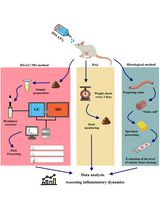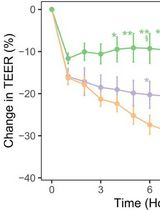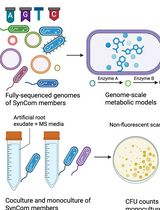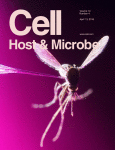- Submit a Protocol
- Receive Our Alerts
- Log in
- /
- Sign up
- My Bio Page
- Edit My Profile
- Change Password
- Log Out
- EN
- EN - English
- CN - 中文
- Protocols
- Articles and Issues
- For Authors
- About
- Become a Reviewer
- EN - English
- CN - 中文
- Home
- Protocols
- Articles and Issues
- For Authors
- About
- Become a Reviewer
Spore Preparation Protocol for Enrichment of Clostridia from Murine Intestine
Published: Vol 7, Iss 10, May 20, 2017 DOI: 10.21769/BioProtoc.2296 Views: 8023
Reviewed by: Andrea PuharAna Santos AlmeidaEmilie Viennois

Protocol Collections
Comprehensive collections of detailed, peer-reviewed protocols focusing on specific topics
Related protocols

HS–GC–MS Method for the Diagnosis of IBD Dynamics in a Model of DSS-Induced Colitis
Olga Yu. Shagaleeva [...] Natalya B. Zakharzhevskaya
Mar 20, 2025 3068 Views

In Vitro Co-culture of Bacterial and Mammalian Cells to Investigate Effects of Potential Probiotics on Intestinal Barrier Function
Ajitpal Purba [...] Dulantha Ulluwishewa
Jun 20, 2025 2437 Views

In Silico Prediction and In Vitro Validation of Bacterial Interactions in the Plant Rhizosphere Using a Synthetic Bacterial Community
Arijit Mukherjee [...] Sanjay Swarup
Nov 5, 2025 1617 Views
Abstract
In recent years, many spore-forming commensal Clostridia found in the gut have been discovered to promote host physiology, immune development, and protection against infections. We provide a detailed protocol for rapid enrichment of spore-forming bacteria from murine intestine. Briefly, contents from the intestinal cecum are collected aerobically, diluted and finally treated with chloroform to enrich for Clostridia spores.
Keywords: SporesBackground
Chloroform kills vegetative bacterial cells but not spores and thus is a useful treatment for enriching Clostridia, the dominant spore-forming group in the mammalian intestine. Experimental procedures for chloroform treatment of mouse feces exist (Momose et al., 2009; Yano et al., 2015). However, they utilize specialized equipment including an anaerobic chamber. We realized that several brief exposures to oxygen occur during experimental manipulation of intestinal contents in preparation for and after chloroform treatment. Therefore, we reasoned the sufficient recover of murine spore-forming bacteria could be obtained without the use of an anaerobic chamber. Since spore-forming Clostridia are a dominant species in the mammalian intestine, this protocol could potentially be used for isolation of spores from the intestines of other mammalian organisms, including larger rodents, primates, and humans.
Materials and Reagents
- Sterile 1.5 ml microcentrifuge tubes (Eppendorf, catalog number: 022363204 )
- 15 ml tubes
- Female (male mice may be used if necessary) C57BL/6 mice aged 8-12 weeks (THE JACKSON LABORATORIES)
- Compressed CO2 gas in cylinder (AirGas)
- Chloroform (Sigma-Aldrich, catalog number: 288306 )
- Sterile PBS pH 7.4 (Reference 2)
Equipment
- Sterile necropsy instruments (operating scissors, tweezers and forceps) to avoid contamination
- Shaker with 200 rpm capacity and 37 °C setting (or inside 37 °C room)
Procedure
- Without pre-charging the chamber, place the animal(s) in the chamber and introduce 100% carbon dioxide (whenever possible euthanize animals in their home cage). Open the CO2 tank or valve regulator to initiate flow of gas. A fill rate of about 10% to 30% of the chamber volume per minute with carbon dioxide, added to the existing air in the chamber should be appropriate to achieve a balanced gas mixture to fulfill the objective of rapid unconsciousness with minimal distress to the animals. Wait approximately 3-5 min for animal to stop moving or breathing. Maintain CO2 flow for a minimum of 1 min after respiration ceases. Death was confirmed by cervical dislocation.
- Open the abdominal cavity using operating scissors to remove the cecum. Using operating scissors, keep the cecum intact by carefully excising to not lose any contents.
- Open the cecum with operating scissors and add the cecal contents to a 1.5 ml microcentrifuge tube on ice.
- Take cecal contents and dilute 1:10 in PBS (w/v). Add chloroform in a final concentration of 3% (v/v).
- Incubate the cecal contents/chloroform mixture by shaking at 200 rpm at 37 °C for 30 min.
- Allow the chloroform to settle to the bottom of the tube at room temperature (approximately 20 min).
- Remove top aqueous layer to recover the spores and add to a sterile 1.5 ml tube. Be careful not to take any chloroform that has settled to the bottom of the tube.
Data analysis
Real-Time PCR using Clostridia specific primers were used for subsequent analysis of log CFU of Clostridia in feces of mice that received spores isolated by this protocol (Rivera-Chávez et al., 2016). Fold changes of ratios (mRNA levels) were transformed logarithmically prior to statistical analysis. An unpaired Student’s t-test was used to determine whether differences in fold changes between groups were statistically significant (P < 0.05).
Notes
- Expect 100 to 200 mg of cecal contents per mouse.
- It is very important to collect the cecal contents as quickly as possible once mouse has been euthanized to ensure maximum recovery of spores.
- Use sterile technique to not contaminate cecal contents during transfer into a sterile 1.5 ml tube.
- If pooled cecal contents from multiple mice will be prepared, then 15 ml tubes could be used to accommodate greater volumes.
- Isolated spores should be used fresh (same day of isolation) to ensure maximum viability of spores. We do not recommend storing spores.
Acknowledgments
This protocol was adapted from Momose et al., 2009. This work was supported by Public Health Service Grants AI096528 (A.J.B.), AI112949 (A.J.B.), AI103248 (S.E.W.), AI112241 (C.A.L.), OD010931 (E.M.V.), and AI060555 (E.M.V. and F.R.-C.).
References
- Momose, Y., Maruyama, A., Iwasaki, T., Miyamoto, Y. and Itoh, K. (2009). 16S rRNA gene sequence-based analysis of clostridia related to conversion of germfree mice to the normal state. J Appl Microbiol 107(6): 2088-2097.
- Phosphate-buffered saline (PBS) (2006). Cold Spring Harb Protoc.
- Rivera-Chávez, F., Zhang, L. F., Faber, F., Lopez, C. A., Byndloss, M. X., Olsan, E., Xu, G., Velazquez, E. M., Lebrilla, C., Winter, S. E. and Bäumler, A. J. (2016). Depletion of butyrate-producing Clostridia from the gut microbiota drives an aerobic luminal expansion of Salmonella. Cell Host Microbe 19: 443-454.
- Yano, J. M., Yu, K., Donaldson, G. P., Shastri, G. G., Ann, P., Ma, L., Nagler, C. R., Ismagilov, R. F., Mazmanian, S. K. and Hsiao, E.Y. (2015). Indigenous bacteria from the gut microbiota regulate host serotonin biosynthesis. Cell 161(2): 264-276.
Article Information
Copyright
© 2017 The Authors; exclusive licensee Bio-protocol LLC.
How to cite
Velazquez, E. M., Rivera-Chávez, F. and Bäumler, A. J. (2017). Spore Preparation Protocol for Enrichment of Clostridia from Murine Intestine. Bio-protocol 7(10): e2296. DOI: 10.21769/BioProtoc.2296.
Category
Microbiology > Microbe-host interactions > Bacterium
Biochemistry > Other compound > Spore
Do you have any questions about this protocol?
Post your question to gather feedback from the community. We will also invite the authors of this article to respond.
Share
Bluesky
X
Copy link









